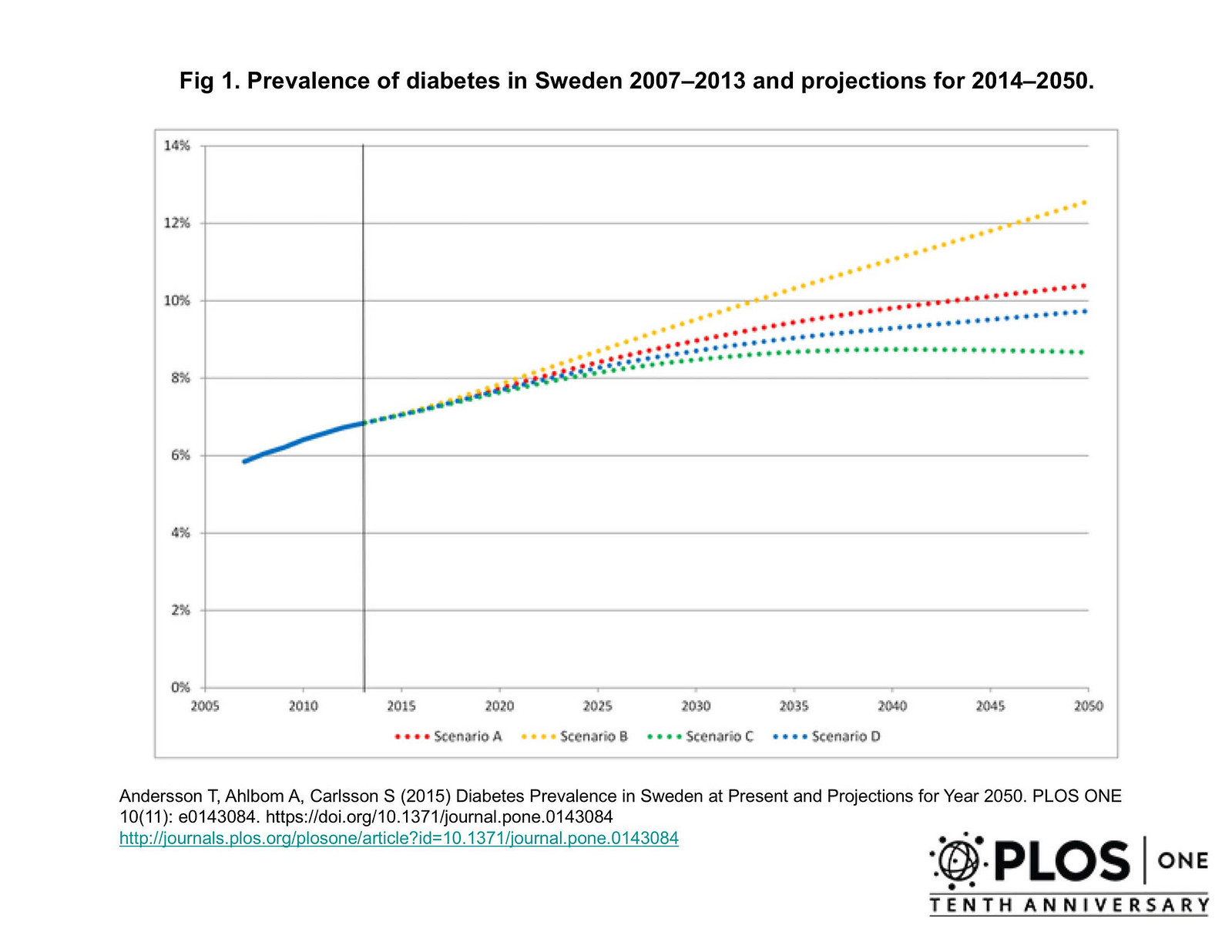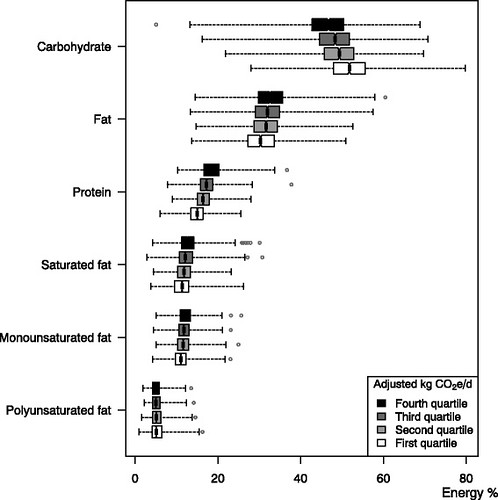
Andersson T, Ahlbom A, Carlsson S. Diabetes Prevalence in Sweden at Present and Projections for Year 2050. Icks A, editor. PLoS One [Internet]. Public Library of Science; 2015 Nov 30 [cited 2017 Dec 29];10(11):e0143084. http://dx.plos.org/10.1371/journal.pone.0143084
I read this piece because I read this piece: Just Read: Is a diet low in greenhouse gas emissions a nutritious diet? (or what if what was thought to be a nutritious diet is actually higher in greenhouse gas emissions because it is poorer for health)
This is a projection of the future burden of diabetes in Sweden, whose prevalence is lower than in the United States. The projection was done using prescription records (which are nationalized) with a multiplier to account for the fact that 22% of people with diabetes in Sweden are not being treated pharmacologically.
In Europe, diabetes prevalence has been projected to rise from 8.5% (2013) to 10.3% (2035) in adults 20–79 years, as a consequence of the aging population [1]. However, if incidence of diabetes is rising as well, this forecast is an underestimation.Andersson T, Ahlbom A, Carlsson S. Diabetes Prevalence in Sweden at Present and Projections for Year 2050. Icks A, editor. PLoS One [Internet]. Public Library of Science; 2015 Nov 30 [cited 2017 Dec 29];10(11):e0143084
There’s chilling data mentioned about the United States as well:
In the US, Boyle et al modeled the prevalence of diabetes to be 21% by 2050 in the light of stable incidence and high mortality, whereas a rise in incidence and relatively low mortality will result in a prevalence of 33%Andersson T, Ahlbom A, Carlsson S. Diabetes Prevalence in Sweden at Present and Projections for Year 2050. Icks A, editor. PLoS One [Internet]. Public Library of Science; 2015 Nov 30 [cited 2017 Dec 29];10(11):e0143084
Obesity mentioned, Diet not at all
The relationship to the other article referenced above regards the Nordic Nutritional Recommendations (NNR) , which to my eyes, mirror the current U.S. Dietary recommendations for which there is little to no evidence for.
I’m copying these from the previous paper referenced, which is @CreativeCommons licensed. They show a reliance on a high amount of carbohydrates, moderate to low fat, and strong bias against saturated fat.
Nordic Nutritional Recommendations – summary
|
Recommended intakea |
Goal for menu planningb |
||
|---|---|---|---|
|
Women |
Men |
Nutrient/MJ |
|
|
Energy (kJ)c |
8,500 |
11,000 |
|
|
Protein (E%)d |
10–20 |
10–20 |
|
|
Carbohydrates (E%)d |
45–60 |
45–60 |
|
|
Fat (E%)d |
25–40 |
25–40 |
|
|
Saturated fat (E%)d |
<10 |
<10 |
|
|
Monounsaturated fat (E%)d |
10–20 |
10–20 |
|
|
Polyunsaturated fat (E%)d |
5–10 |
5–10 |
|
|
β-carotene (μg)e |
– |
– |
– |
|
Vitamin C (mg) |
75 |
75 |
8 |
|
Folate (μg) |
300/400f |
300 |
45 |
|
Fiber (g) |
25–35 |
25–35 |
3 |
|
Vitamin B12 (μg) |
2.0 |
2.0 |
0.2 |
|
Iron (mg) |
9/15g |
9 |
1.6 |
|
Zinc (mg) |
7 |
9 |
1.1 |
|
Vitamin D (μg) |
10 |
10 |
1.3 |
|
Retinol (μg)e |
– |
. |
. |
|
Retinol equivalents (RE)h |
700 |
900 |
80 |
|
Calcium (mg) |
800 |
800 |
100 |
What’s being eaten vs what’s recommended

It turns out from this study of food frequency that none of the groups studied are below the recommended level of saturated of fat in their diet – all groups are exceeding the 10 % recommendation.
If the impact of the recommendations is the same in Sweden as it is in the United States, fat intake would not be expected to go down; instead, increases of carbohydrates will be the result*, which will move the population into more diabetogensis.
Impact
Prevalence of diabetes in Sweden rose between 2007 and 2013, but incidence remained relatively constant.
This fits with our previous observations from the Stockholm County where incidence of diabetes rose by 3% annually between 1990 and 2002, but leveled off from 2002 onwards. A similar development has also been reported in Denmark [4].
If incidence of diabetes would start to rise even at a modest level, the influence on the future burden of diabetes would be substantial; a 1% annual increase in incidence would generate a prevalence of 12.6% by year 2050 and the number of patients would be 21% higher than in a scenario with constant incidence. This scenario is not unlikely given that prevalence of overweight and obesity has been increasing steadily in Sweden over the last decades [6, 16]. Most importantly, even with a substantial decline in incidence, prevalence of diabetes will continue to increase in Sweden as a result of changes in age structure and survivalAndersson T, Ahlbom A, Carlsson S. Diabetes Prevalence in Sweden at Present and Projections for Year 2050. Icks A, editor. PLoS One [Internet]. Public Library of Science; 2015 Nov 30 [cited 2017 Dec 29];10(11):e0143084
.
